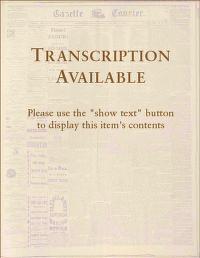|

Mary: Lamson family servant

"Amendment of the Constitution the Only Way to Kill Slavery" article from Gazette and Courier newspaper
|
Summary and Objective
Students will understand that African Americans were promised freedom during the period of Reconstruction, but that true freedom was not achieved at that time. Students will begin the activity by examining the views of freedom expressed in Lincoln's Gettysburg Address and in other documents. With that historical view in mind, students will then work in small groups to examine collections of primary sources on subjects such as lynching, Jim Crow laws, political cartoons, sharecropping, education, and the Ku Klux Klan in order to examine the consequences of freedom for African Americans during the period of Reconstruction. Students will answer a common set of questions for each resource, then use that information to complete a chart that lists views of freedom expressed in their sources. Students will evaluate the position of African Americans as presented in their resources in three categories: economic, political, and social. A wrap-up discussion will evaluate the degree to which the "original" promise of freedom was achieved in the Reconstruction period. At home, students will evaluate the Presidential and Congressional Reconstruction Plans to see which view of freedom predominated and why.
Teaching Plan
Step 1.
Activator: Students will be asked to write down their own definitions of "freedom." Share answers with class.
Step 2.
As a class, students will read (a) The Gettysburg Address; (b) the 13th, 14th, and 15th amendments from their textbook; and (c) the article from the Gazette and Courier newspaper. List the freedoms "promised" to African Americans by the government and other northerners. To save time, have different groups read different documents. Through discussion or at the board, students share lists.
Step 3.
Divide Students into small groups (2-3 or 3-4). Distribute several documents to each group on one of the six topics listed in step 4, plus a set of questions to answer for each resource. Students examine the documents and answer the questions for each. QUESTIONS TO ANSWER: 1.What do you see in the primary source? 2. If you are analyzing a political cartoon, what do the symbols represent? 3. From whose perspective is this document or resource? 4. What does this source tell you about the meaning of freedom – socially, politically, or economically?
Step 4.
TO THE TEACHER: The following are the categories that students will examine in investigating the meaning of freedom: a. Lynchings b. Jim Crow Laws c. Education d. Sharecropping e. Ku Klux Klan f. Political cartoons ** Students may be divided into groups according to the above categories or be given a variety of resources dealing with more that one topic. This activity can also be done as an internet "scavenger hunt" using the websites provided with this activity. This activity can also be done with a variety of levels of classes if the teacher provides the resources. This activity can be completed in two 50-minute class periods with a homework assessment.
Step 5.
TO THE TEACHER: The resources needed for each category may be found at the following sites. These may be printed for student use or students may be directed to the computer to find the documents. (1) Lynching a. www.withoutsanctuary.org (photos # 1, 5, 11, 20, 24) b. www.jimcrowhistory.org – go to Image Gallery, Jim Crow collection (2) Jim Crow laws: a. www.jimcrowhistory.org (go to Teacher Resources, then narratives, then Jim Crow Etiquette) b. www.pbs.org/wgbh/amex/reconstruction/nast/sf_nast_06.hml c. Document: Mary Lamson Family Servant (3) Education: Go to www.civilwarmemory.typepad.com/civil_war_memory/southern_history/index (southern oral history project video (1st 6 minutes) d. Sharecropping: Accounts at www.jimcrowhistory.org (go to Teacher Resources, then narratives, then Sharecropping e. Ku Klux Klan: www.authentichistory.com; then to images and artifacts; then to 1870 KKK poster f. Political Cartoons: (1) www.authentichistory.com/postcivilwar/artifacts (2) next, 1872 First Blacks in Congress, then to Political cartoons (post-civil war, 1860's and 1870's cartoons)
Step 6.
As groups finish their analysis of documents / resources, students will come up to the board to fill in information on a three-column chart (large project paper could be used instead of a board to be saved for the next class). This could also be done as a group or individual "foldable."The chart will be titled, "The Meaning of Freedom." The three columns will be: ECONOMIC, POLITICAL, SOCIAL.
Step 7.
Class Discussion: To what degree was the government's and African Americans' view of freedom realized following the Civil War? Use information from documents and other sources to examine the political, economic, and social status of African Americans following the Civil War. Students should be responsible for copying information from the classroom chart to one of their own.
Step 8.
At home writing assignment: Students examine the Presidential and Congressional plans for Reconstruction that they have previously studied, and hypothesize which view of freedom predominated and why. To what degree were the social, political, and economic rights of African Americans protected by the government following the Civil War?
|




